Specialist
Three months later the Free Cancer Hospital opened, initially as a dispensary, at No. 1 Cannon Row, Westminster, providing drugs for palliative rather than curative care.
It was the second hospital to be founded by Dr Marsden, whose wife had died of cancer, and the first in the country to be dedicated to research into the disease. As with Dr Marsden's first hospital, the Royal Free Hospital, no payment was required for admission.
There soon proved a need for in-patient beds and 6 beds were made available, but these were not enough so, in November 1852, Hollywood Lodge (House) - a detached house off the Fulham Road in West Brompton - was leased for £63 a year. The 'solid and square-built' building had gas lighting for all but the topmost rooms. At its rear was a garden.
The Hospital had 20 beds, although there were only enough funds initially to open 6 beds.
The Hospital Committee had hoped eventually to extend the building to 60 beds, but ownership of the land titles proved difficult and the plan was abandoned. Instead, it was decided to build a hospital in a new site and fund-raising began for the project.
By 1853 some 654 patients had been seen, of whom 80% were women. Surgery was the only plausible treatment, but this was performed without anaesthesia or antisepsis.
In 1854 the dispensary moved to No. 5 Waterloo Place, Pall Mall, where administrative offices were also set up. In 1855 it moved again, to No. 167 Piccadilly.
In 1855 Baroness Burdett-Coutts (1814-1906), one of the great philanthropists of the day, loaned £3,000 to the Hospital Committee. This enabled the purchase of a one-acre freehold site on the Fulham Road at a cost of £4,500 on which to build a new hospital.
On 30th May 1859 the Baroness laid the foundation stone.
The new building opened in 1862 with 80 beds in six wards, but finances only permitted 30-40 to be occupied. The design allowed for expansion to 300 beds by adding wings to the front block so that the square site would be outlined by buildings, with a garden in the centre. (The plan was never completed due to insufficient income.)
In 1869 a 'chloroformist' was added to the staff (the title was changed to 'anaesthetist' in 1897), but antisepsis was only established in the operating theatre nine years after Joseph Lister had introduced carbolic acid into surgical practice in 1865.
In 1878 a further portion of the site was purchased and in 1881 a new wing was built at a cost of £24,349. It contained more wards and the additional space enabled the dispensary (Out-Patients Department) and administrative offices to move from the Piccadilly site to Fulham Road. (However, the Board Room and the Secretary's Office remained in Piccadilly until 1884.)
In 1883 extensions were built to the east and west of the main block. The Hospital then had 120 beds.
In 1885 a new facade of red brick with stone, mixing Jacobethan and Baroque elements, was added.
In 1887 a small freehold cottage, situated in the grounds of the Hospital, was converted for use as a ward for incurable cases (it was demolished in 1911 when a rear extension of the east wing was built).
Work began on a chapel in 1889. It was officially opened in 1892 by the Bishop of London and had cost £4,000 to build.
In 1892 the Hospital had 100 beds.
By the end of the century the medical staff comprised 6 surgeons, 2 anaesthetists, 2 House Officers and 2 pathologists. Surgery remained the only treatment available.
In 1901 treatment with ionizing radiation was provided in addition to surgical treatment. Radium was acquired in 1903 and a Radiological and Electrotherapy Department was established to provide diagnostic and therapeutic services - as well as X-ray and radium, treatments were with galvanism, Faradism, electrolysis and 'high frequency' electric current.
A Nurses' Home was built on the west side of the grounds in 1904 (it was demolished in 1951). Nurses has previously been housed on the top floor of the main building.
In 1908 the Hospital had 110 beds. Patients stayed on average for 41 days. The weekly cost of an in-patient was £2 12s 10d (£2.64).
In 1909 a Research Institute was established. (It was officially opened in 1911 by Prince Arthur, Duke of Connaught and Strathearn.)
In 1910 the Hospital was incorporated by Royal Charter by King George V, and was renamed The Cancer Hospital (Free).
In 1911 the east wing was extended and, in 1912, a Radiotherapy Department established. This was enlarged in 1914 and also in subsequent years.
During WW1 (1914-1918) 70 beds were reserved for military patients.
On 21st October 1925 a new operating theatre was opened by Prince Arthur. New accommodation had also been built for the ward maids. Nos. 171, 173 and 175 Fulham Road were acquired with a view to future expansion at a cost of £5,950.
In 1929 a Radium Department was established.
In 1932 Nos. 171 to 175 Fulham Road were demolished and work began on a new extension at the west end of the main block. The 5-storey building had cost £150,000 to build. It was named Granard House, after the President of the Hospital and was officially opened by Queen Mary on 9th May 1934. It contained a new Out-Patients Department with well-equipped consulting rooms and offices fitted out with oak furniture. The walls were painted cream and the flooring was of rainbow-coloured rubber. The new Radiology Department was devoted to diagnostic investigations, including X-ray examination, and to treatments by radium, high-voltage X-ray, artificial sunlight and electricity. The high-voltage X-ray apparatus had been constructed by a British firm and was the first of its kind in the U.K.
Granard House also contained two wards with 29 beds for private patients. The weekly charge for a private in-patient was 4 to 6 guineas (£4.20 to £6.30).
A new boiler house had also been added to supply the entire Hospital with hot water for domestic and heating purposes.
In April 1936 the Hospital was renamed the Royal Cancer Hospital by King Edward VIII.
In 1938 it had 159 beds, of which 29 were private.
In 1939 Alfred Chester Beatty bought the former Freemasons Hospital to house the Research Institute. It was renamed the Chester Beatty Research Institute (in 1954 it became the Institute of Cancer Research).
During WW2 the Hospital's radium supply was buried in a pit, some 40 feet (12 metres) deep, in case of bomb damage to the buildings. Pollards Wood House, a country house with 57 aces of land in Chalfont St Giles, was purchased in 1941 in case the Hospital needed to be evacuated. It never was, so the property was used as a convalescent home and later taken over by the Research Institute.
In 1944 the X-ray and the Radiotherapy Departments separated, with the former providing diagnostic services and the latter treatments.
The Hospital joined the NHS in 1948 as a postgraduate teaching hospital with 156 beds (including 29 private). The Committee hoped to expand onto the adjacent London Oratory School site, but the Ministry of Health was reluctant.
In 1952 an Out-Patients Department was built (later extended in 1973). Stewart's House and Nos. 1-10 Stewart's Grove were acquired for Hospital purposes.
In 1954 the Hospital was renamed the Royal Marsden Hospital in honour of its founder.
In the early 1960s redevelopment began on the Hospital site. In order to treat more patients and train more doctors, a branch was opened in Sutton, Surrey in 1963. As well as the newly built ward block, the Sutton branch occupied a few buildings of the former Downs Hospital.
On 1st May 1963 the Wallace Wing was opened by the Minister of Health, Enoch Powell. The building contained a new Out-Patients Department, a new Radiotherapy Department and research laboratories.
In 1966 the Hospital had 214 beds, 19 of which were private.
In 1970, when the London Oratory School moved to new premises, the Hospital acquired the buildings for non-patient purposes.
In 1982, following a major reorganisation of the NHS, the Hospital was designated a Special Health Authority, under the control of its Board of Governors.
During the cold winter of 1986 the operating theatres froze and operations had to be cancelled for a week. An Appeal to raise £5m to replace the 50-year-old theatres was raised. A new block would be built at the rear of the site which would also contain a ward for gynaecological patients and one for patients with head and neck cancer, and accommodation for two linear accelerators. (The new block - the Chelsea Wing - opened in 1992.)
In 1990 the Hospital had 199 beds.
In 1993, following the Tomlinson Report, the Hospital was threatened with closure by the North West Thames Regional Health Authority, with its services, and those of the Royal Brompton Hospital, being moved to Charing Cross Hospital and their sites sold for redevelopment. However, both Hospitals were reprieved and remained where they were.
In April 1994, following the introduction of the 'internal market' system within the NHS, the Hospital came under the control of the Royal Marsden NHS Trust.
It had 152 beds in 2001.
In April 2004 it became one of the first NHS Foundation Trusts.
On 2nd January 2008 a major fire broke out in a plant room on the top floor of the Chelsea Wing. The smoke-filled building had to be evacuated. The entire roof was burned through and five operating theatres and two wards were put out of action. Despite the drama, there were no injuries apart from two members of staff affected by smoke inhalation. By 7th January the Out-Patients and Radiotherapy Departments had re-opened and, a few days later, the evacuated in-patients transferred back from the neighbouring Royal Brompton Hospital.
Present status (August 2008)
The Hospital remains operational. Despite its cramped site, it has
an international reputation in the diagnosis and treatment of
cancer. Together with the Institute of Cancer Research, it has become the largest comprehensive research centre for the disease in Europe.
UPDATE: January 2017
In 2013 the Royal Brompton Hospital announced plans to consolidate its campus onto its Dovehouse Street site. To this end, it would sell off its Fulham Wing. The Trust of the Royal Marsden Hospital immediately expressed interest in acquiring the site as the Wing in Fulham Road is adjacent to the Hospital.
In 2014 the Hospital lodged a planning application for a £65m redevelopment of the Fulham Wing to provide oncological services for in-patients and out-patients.
In May 2015 the £14m Reuben Foundation Imaging Centre was officially opened by the Chief Executive of NHS England, Simon Stevens.
In January 2016 the Ralph Lauren Centre for Breast Cancer Research opened, part funded by a donation from the American clothing designer, Ralph Lauren.
It is unclear whether a decision had been made about the future of the Fulham Wing.
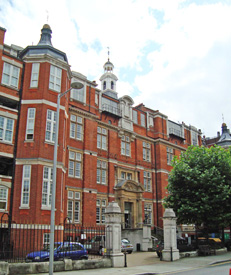
The main entrance on Fulham Road.
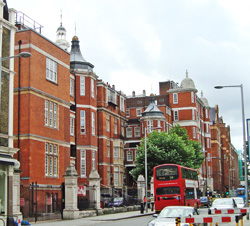
The frontage of the Hospital on Fulham Road - with the Fulham Wing of the Royal Brompton Hospital just visible in the distance.
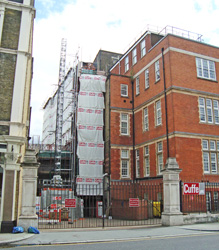
The Chelsea Wing, built behind the east wing extension, is covered by scaffolding following the fire.
N.B. Photographs obtained in November 2016
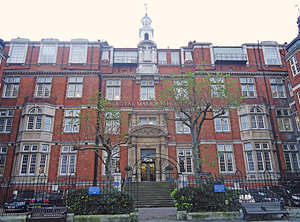
The central block.
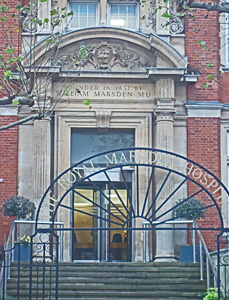
The main entrance.
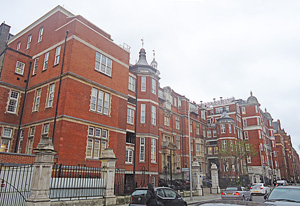
The frontage along Fulham Road.
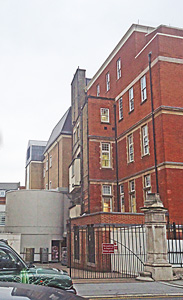
The Chelsea Wing, now repaired, is just visible behind the east wing.
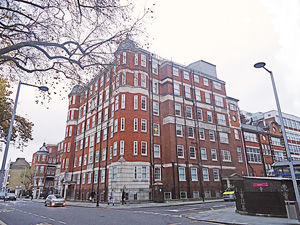
Granard House is on the corner of Fulham Road and Dovehouse Street. The Grade II listed building was refurbished in 2011 at a cost of £6m. It has 21 en-suite rooms for private patients.
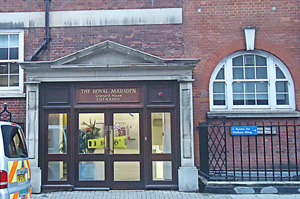
The main entrance to Granard House is at No. 98 Dovehouse Street.
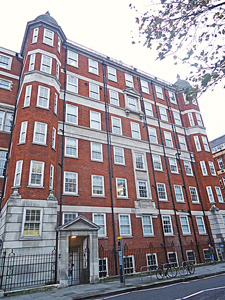
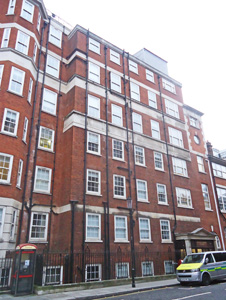
The Fulham Road elevation of Granard House (left) and the Dovehouse Street elevation (right).
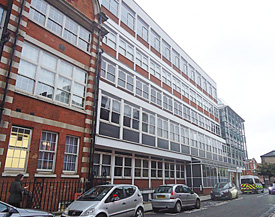
The Wallace Wing is next door to Granard House in Dovehouse Street.
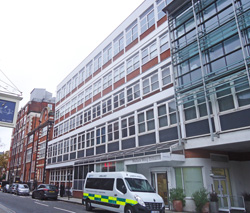
The main entrance to the Wallace Wing (above and below).
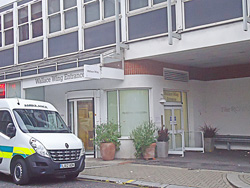

The Markus Centre (above and below) is beside the Wallace Centre.
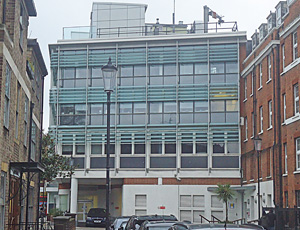
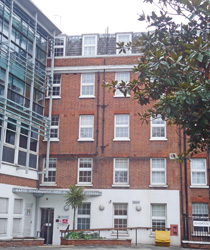
The Rapid Diagnostic and Assessment Centre is in Mulberry House, adjacent to the Markus Centre.
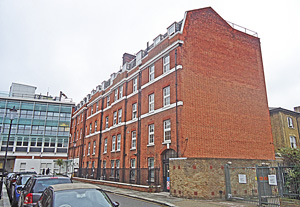
Mulberry House contains various Hospital departments and offices.
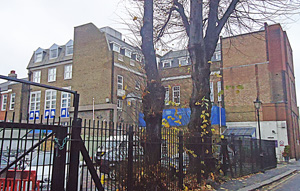
The site of Grove House (now a car park) and the Education & Conference Centre.
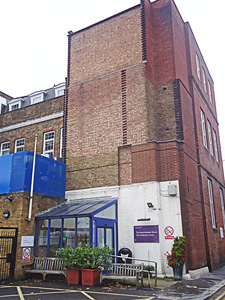
The rather plain entrance to the Conference Centre.
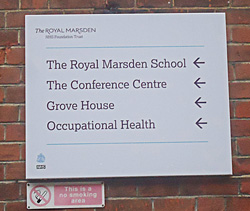
Signage along Stewart's Grove.

A glimpse of the rear of the Chelsea Wing.
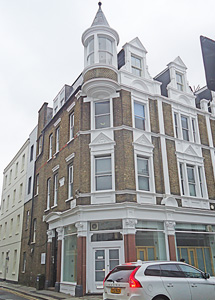
Avenue House on the corner of Fulham Road and Stewart's Grove.
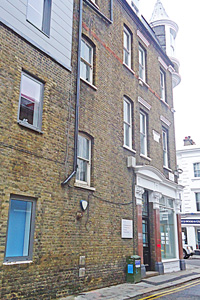
The entrance to Avenue House in Stewart's Grove (above and below).
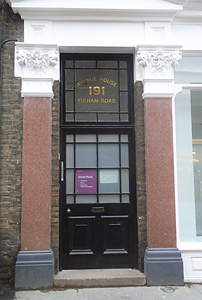

Stewart's House is next-door to Avenue House. Both properties belong to the Royal Marsden Cancer Charity.
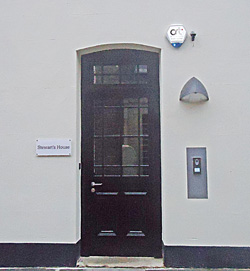
The entrance to Stewart's House.
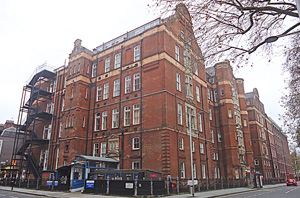
The Hospital wishes to acquire the Fulham Wing of the Royal Brompton Hospital, located on the corner of Fulham Road and Dovehouse Street.
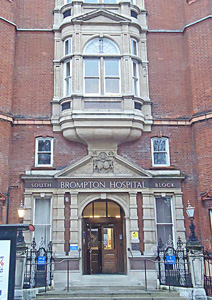
The main entrance of the Fulham Wing.
(Author unstated) 1867 William Marsden, M.R.C.S.E., M.D. British Medical Journal 1 (317), 96-97.
(Author unstated) 1934 Cancer Hospital's new buildings. British Journal of Nursing (June), 150-151.
(Author unstated) 1951 The Royal Cancer Hospital, Fulham Road, London, 1851-1951. A Short History of the Royal Cancer Hospital Prepared for the Centenary 1951. London, The Board of Governors.
(Author unstated) 1951 Centenary of Royal Cancer Hospital. British Medical Journal 1 (4714), 1090.
(Author unstated) 1963 Medical News. British Medical Journal 1 (5340), 1295.
(Author unstated) 1963 New Surrey branch of Royal Marsden. British Medical Journal 1 (5342), 1423.
Loshak D 1987 The Royal Marsden Hospital. The Times, 25th June, 16-17.
Marsden Sandwith F 1960 Surgeon Compassionate: The Story of Dr William Marsden, Founder of the Royal Free and Royal Marsden Hospitals. London, Peter Davies.
Smith M, Sakula A 1994 Hospital Names. London, Royal Society of Medicine Press.
Wiltshaw E 1998 A History of the Royal Marsden Hospital. Edgware, Altman.
http://archiseek.com
http://chelseasociety.org.uk
http://news.bbc.co.uk
http://research.omicsgroup.org
https://rbkclocalstudies.wordpress.com
https://royalmarsden.nhs.uk
www.british-history.ac.uk
www.calderlead.co.uk
www.choughfire.co.uk
www.cuffeplc.com
www.flickr.com
www.fusingglass.co.uk
www.historad.com
www.iceniprojects.com
www.londonremembers.com
www.medicalarchitecture.com
www.rbkc.gov.uk (1)
www.rbkc.gov.uk (2)
www.royal.uk
www.theguardian.com
Return to home page